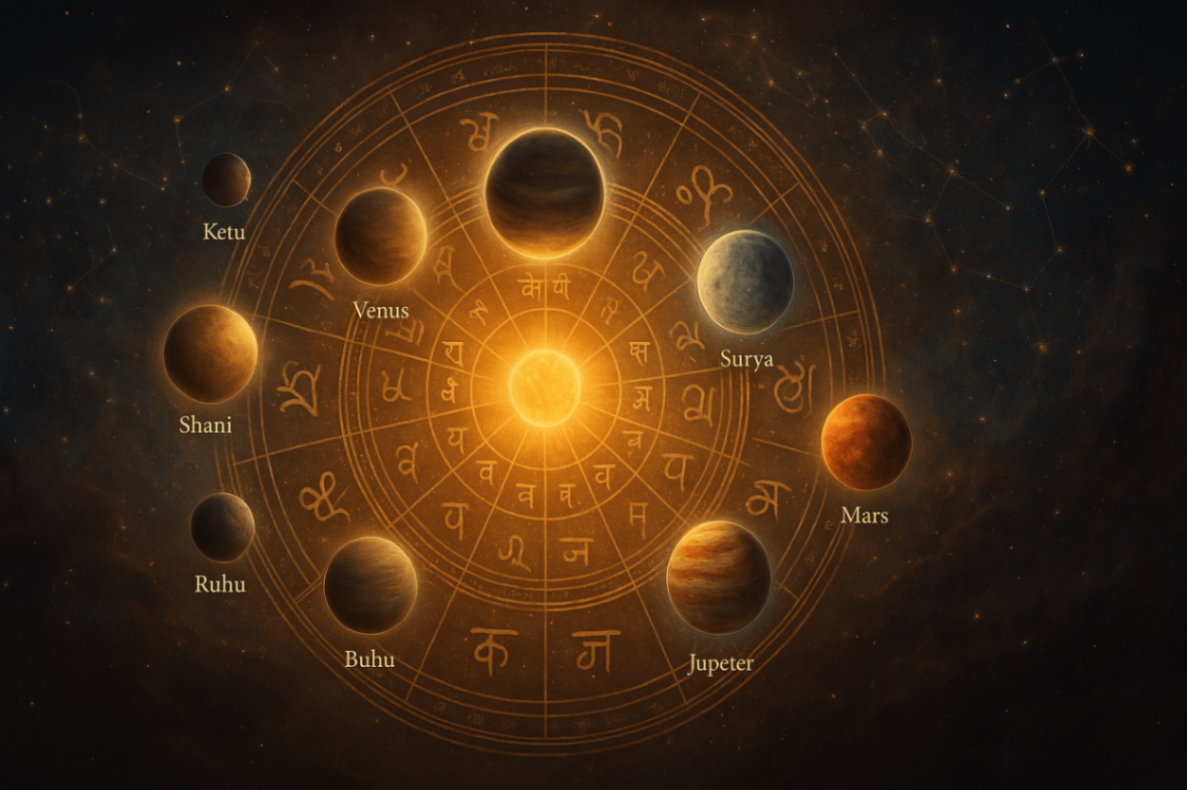Unlocking the Secrets of Dashas in Vedic Astrology

In Vedic Astrology, the concept of dashas plays a pivotal role in shaping our lives. While planets influence our nature and tendencies, it is the dasha systems, or planetary periods, that determine when these influences manifest. Understanding what is dasha in astrology can unlock the secrets of our destiny, revealing the timing of significant events and life changes.
The Hierarchy of Influence: Planets and Time

Astrology suggests a hierarchy of influence. At the base level, humans are affected by planets. Each planet imparts specific qualities to individuals. For instance, Mars brings energy and assertiveness, while Jupiter offers wisdom and expansion.
However, planets themselves are governed by time. They exert their influence during their designated dasha periods. This means that while planetary positions set the stage, it is the timing provided by the dashas that activates their effects.
The Importance of Dashas Over Planets
While planets shape our tendencies, dashas determine when these tendencies will manifest. A persons life is significantly affected by the dasha they are experiencing. This is why two people with similar planetary positions can have vastly different life experiences.
When consulting an astrologer, its crucial to look at the dasha first. The dasha indicates which planet is currently influencing the individual and which areas of life will be affected. This approach is more effective than examining the entire natal chart, which remains static throughout life.
The Sequence of Dashas: Malefic and Benefic Patterns
In Vedic Astrology, the most commonly used system is the vimshottari mahadashas. This system divides a human lifespan of 120 years among the nine planets. Each planet rules over a specific number of years, and the sequence follows a set order from time of birth:
Ketu - 7 years
Venus - 20 years
Sun 6 years Dasha
Moon 10 years Dasha
Mars 7 years Dasha
Rahu 18 years Dasha
An essential principle in this sequence is the alternation between malefic and benefic planets. This pattern ensures that life has a balance of positive and challenging periods:

Ketu (Malefic)
Venus (Benefic)
Sun (Malefic)
Moon (Benefic)
Mars (Malefic)
Rahu (Malefic)
Jupiter (Benefic)
Saturn (Malefic)
Mercury (Benefic)
This alternation means that one never experiences entirely good or entirely bad times continuously. The durations also vary, creating a rhythm of highs and lows similar to the patterns seen in a cardiogram.
Odd and Even Dashas: The Cycle of Life
Another critical concept is the distinction between odd and even dashas:
Odd-numbered Dashas (1st, 3rd, 5th, 7th, 9th): Generally considered challenging periods. They often bring obstacles, transformations, and tests.
Even-numbered Dashas (2nd, 4th, 6th, 8th): Typically favorable, bringing growth, expansion, and fulfillment.
Understanding this cycle helps in anticipating lifes ebb and flow. For instance, the second dasha is usually associated with positive developments, while the third dasha may introduce challenges.
Understanding Each Dashas Impact
First Dasha: Ketu - The Physical Growth Phase (Odd Dasha)
The first dasha corresponds to Ketu, lasting for seven years. Being an odd-numbered dasha, it is a period of adjustment and foundational challenges. During this time, the focus is on physical growth and survival. A child develops basic abilities like walking, speaking, and recognizing family members. Material possessions have little value during this period.
Second Dasha: Venus - Wealth and Family Values (Even Dasha)
The second dasha is ruled by Venus and spans 20 years. As an even-numbered dasha, it brings favorable conditions. This period is crucial for developing values, wealth, and relationships. Individuals learn to speak, understand family dynamics, and begin their education. The foundations laid during this dasha influence ones financial stability and social relationships throughout life.
Third Dasha: Sun - Challenges and Obstacles (Odd Dasha)
Sun dasha comes next, lasting six years. Being an odd-numbered dasha, it introduces obstacles and challenges. As individuals step into the real world, they face practical difficulties and learn to overcome them. This dasha often coincides with early adulthood when people start their careers and face the realities of life.
Fourth Dasha: Moon - Pleasure and Expansion (Even Dasha)
The Moon dasha lasts for ten years and is an even-numbered dasha, associated with pleasure and expansion. During this time, individuals may establish their careers, acquire property, and enjoy material comforts. This period often brings stability and growth in various areas of life.
Fifth Dasha: Mars - Worries and Anxiety (Odd Dasha)
The fifth dasha is ruled by Mars and lasts for seven years. As an odd-numbered dasha, it can bring worries, anxiety, and tension and may give bad effects if afflicted. As responsibilities increase, individuals may experience stress related to family, health, or career. Its essential to remain calm and patient during this dasha.
Sixth Dasha: Rahu - Spirituality and Idleness (Even Dasha)
The Rahu dasha, lasting 18 years, is an even-numbered dasha that encourages spiritual growth and introspection. Its a time to reflect on ones life and focus on inner development. Engaging in spiritual practices can be beneficial during this period.
Seventh Dasha: Jupiter - Transformation (Odd Dasha)
Jupiter dasha spans 16 years and is an odd-numbered dasha considered a time of significant transformation. It can represent an exit point, where individuals may face profound changes. The focus shifts to legacy and the impact one leaves behind.
Eighth Dasha: Saturn - Friendship and Intimacy (Even Dasha)
The Saturn dasha lasts 19 years and is an even-numbered dasha that emphasizes friendships and close relationships. In the later years of life, companionship becomes vital. This period encourages individuals to cherish their relationships and find support in their social circles.
Ninth Dasha: Mercury - Close Connections (Odd Dasha)
The final dasha is ruled by Mercury and lasts 17 years. As an odd-numbered dasha, it brings a culmination of lifes experiences. It deepens the focus on intimate friendships and connections. Wisdom and experiences are shared, and theres an emphasis on communication and understanding.
Interpreting Dashas: A Seven-Step Approach
Interpreting dashas involves a systematic approach to understand how planetary periods influence an individuals life. Here are the seven steps:
Sequence of the Dasha: Identify which dasha is currently active and its position in the sequence (first, second, third, etc.). Recognize whether its an odd or even dasha, which can indicate the general nature of the period.
Planetary Lordship: Determine which houses the ruling planet owns in the natal chart. The houses governed by the planet will be significantly affected during its dasha.
Significator (Karaka): Understand the areas of life the planet represents. For example, Mars is the karaka for courage and property, while Venus signifies relationships and wealth.
Planets Placement: Analyze where the planet is positioned in the chart, including its sign and house. Its strength and dignity in that position will influence the dasha outcome.
Aspects: Consider the houses and planets it aspects. These aspects can modify or enhance the dasha effects.
Navamsa Placement: Examine the planets position in the Navamsa chart, which provides deeper insights into its strength and the karmic implications.
Strength and Dignity: Assess the planets strength through Shadbala and other measures. A strong planet will deliver its results more effectively than a weak one.
Example: Interpreting Mars Dasha
Suppose an individual is entering the Mars dasha:
Sequence: Its the fifth dasha (odd-numbered), indicating potential challenges.
Planetary Lordship: Mars rules specific houses in the natal chart, affecting those areas.
Karaka: Mars signifies courage, siblings, and property.
Placement: Mars is in the ninth house, influencing luck and higher learning.
Aspects: Mars aspects the twelfth and fourth houses, impacting expenses and home life.
Navamsa: Mars is well-placed, enhancing its positive effects.
Strength: Mars is strong, suggesting the individual can overcome obstacles through determination.
Dashas vs. Transits
While dashas represent the timing of planetary influences, transits (gochar) show the current movement of planets through the zodiac. The key difference is that dashas are fixed periods that everyone experiences in a set sequence, whereas transits are dynamic and affect everyone differently based on their natal chart.
Dashas: Inevitable periods that must be experienced. They are like a meal served course by course, whether you like it or not.
Transits: Offer choices, like a buffet. You can choose to engage with the energies presented or not.
Understanding both dashas and transits provides a comprehensive view of astrological influences. Dashas indicate when a planets effects will be felt, and transits show how current planetary movements interact with the natal chart.
The Second Dasha: A Foundation for Life
The second dasha is particularly significant because it lays the foundation for the rest of ones life. During the Venus dasha, individuals develop their values, habits, and relationships. The quality of this period can influence financial stability, educational opportunities, and social connections.
If challenges occur during the second dasha, they may have long-term effects. For instance, difficulties in family relationships or financial hardships can shape ones outlook and opportunities. Therefore, nurturing and supportive environments during this period are crucial.
Changing Your Time: Remedies and Solutions
In Vedic Astrology, there are remedies to mitigate adverse effects of challenging dashas. One such remedy is the concept of changing ones time symbolically. For instance, gifting a clock or watch to someone experiencing a difficult period can represent a change in their time.
This symbolic act can be a gesture of goodwill and may help shift the individuals perspective, providing comfort during tough times. Additionally, ensuring all clocks in ones home are functioning correctly is considered auspicious and can positively influence ones time.
Utilizing Dasha Calculators
To determine your current dasha, you can use a dasha calculator or a vimshottari dasha calculator with DKSCORE AI Platform. These tools use your birth details to calculate the planetary periods you are experiencing. Knowing how to find dasha periods helps in planning and making informed decisions.
The Role of Sub-Dashas: Antardasha and Pratyantar Dasha
Within each mahadasha, there are sub-periods called antardashas, and further subdivisions called pratyantar dashas. Understanding what is pratyantar dasha is important for detailed predictions. These smaller periods provide more precise insights into specific events and experiences.
For example, during a Rahu dasha, the rahu antardasha can intensify its effects. Knowing these periods can help in navigating challenges and leveraging opportunities.
Conclusion
Understanding the secrets of dashas in Vedic Astrology allows us to comprehend the timing of lifes events. The interplay of odd and even dashas, the sequence of planetary periods, and their specific influences provide a roadmap of our destiny. By studying dashas, we gain a deeper awareness of our lifes journey and how to navigate it effectively.
























